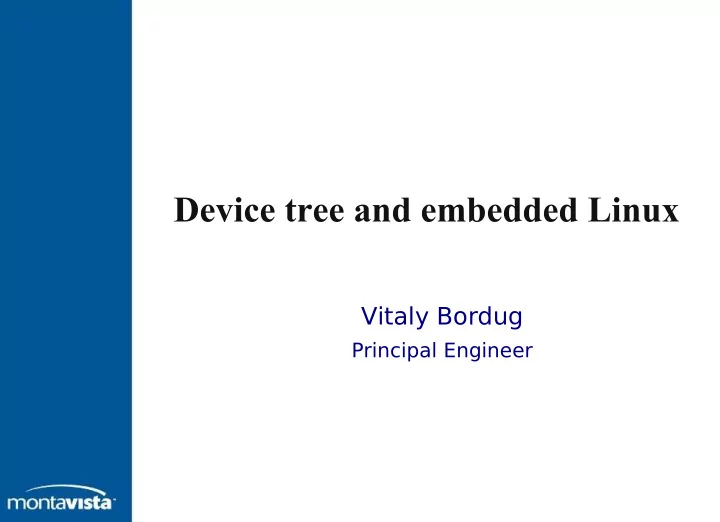

Device tree and embedded Linux Vitaly Bordug Principal Engineer
What is the device tree? • Just a data structure representing: – a tree, layered out system of nodes; – only one parent allowed. • Each node has following properties: – each node has a name; – node contains actual data, that is stored in a list of «properties». • Source and binary of the deice tree MontaVista Software, Inc
Origin of the device tree • Inspired from OpenFirmware (OF) • Addresses problems to determine HW configuration – common stream: desktop, server and BIOS; – embedded platforms specifics. • Why it was needed – devtree is clear, flexible and is a standard; – was a due for ppc/powerpc merge. MontaVista Software, Inc
From theory to implementation • But we were doing good without that stuff... How? – bd_t (already history). Only parameters, no real description. – ARM mach_types. Indicates platforms, but not enough flexibility to handle variants. • Separating structure and code: the DTS (device tree source) way MontaVista Software, Inc
Pros and Cons • +++++++++++++++++++++ – Formal and clear HW description – Multiplatform kernels now possible – Less board-specific code, more efficient device-driver binding • ----------------------------------- – Bigger kernel (in terms of footprint and overall size) – Slower boot time – Complex layers to enable devtree on new architectures MontaVista Software, Inc
OF without real OF • PPC32, u-boot and OF: first steps and questions – where to place the dtb (device tree binary) ; – Support older FW versions/implementations •Add functionality •Maintain backward compatibility • Current state: how to do it right – DTC (device tree compiler) dependancy removed – DTS (device tree source) files for all supported boards are maintained within kernel source – U-boot mainline (from v1.1.3) supporting device tree natively, with backward compatibility MontaVista Software, Inc
What devicetree source looks like MontaVista Software, Inc
Implementation issues and activities to mitigate • Devicetree OF specification does not provide a clear distinction between configuration options and h/w capabilities – Documentation revamp underway – New mailing list — first place to ask.. Not only when you're not sure. (devicetree-discuss@ozlabs.org) • Multicore: model needs clear way for hypervisor to distribute resources between cores – Include devicetree source – Current workaround: devicetree merge MontaVista Software, Inc
What about other architectures ? • Actively considered as an alternative for ARM mach-* mess • We alreade have something to show... [.......OMAP5912osk.......] • What is still todo though: – Support for the U-Boot (take dtb and pass it over to the kernel – Kernel-side dtb support – OF-like interrupt controllers support (get rid of static mapping. Plenty of work :) ) MontaVista Software, Inc
DTS applications: beyond kernel • Stepping outside initial goals and definitions – uImage and its limitations – Use devicetree as a container to construct new uImage • New uImage is already in mainline — what does it mean in terms of support for existing products – Full backward-compatibility – Bunch of flexibility and functionality if it is needed MontaVista Software, Inc
New uImage: how the whole thing works MontaVista Software, Inc
Image tree source example MontaVista Software, Inc
Leveraging the New uImage Implementation • Maximizes flexibility in kernel and RFS combinations: – single and multi-kernel are supported; – allows for support of a single “multiplatform image” with different DTBs. • Not restricted to the kernel: – image tree source can store additional user-defined data - extremely useful to store configurations; – auto-update extended firmware feature was merged to the mainline u-boot see doc/README.update MontaVista Software, Inc
Recommend
More recommend